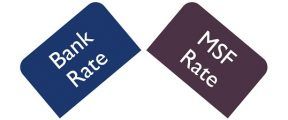 Repo Rate or repurchase auction rate is one at which the Reserve Bank of India, buys back Government Securities, from the commercial banks, based on the level of liquidity, the central bank wants to maintain in the country’s economy. The central bank uses this as a tool to increase or decrease the supply of money in the economy.
Repo Rate or repurchase auction rate is one at which the Reserve Bank of India, buys back Government Securities, from the commercial banks, based on the level of liquidity, the central bank wants to maintain in the country’s economy. The central bank uses this as a tool to increase or decrease the supply of money in the economy.
Marginal Standing Facility (MSF), is a window for banks, to take money on credit from the central bank, by pledging Government securities, in the case of emergency, when the interbank liquidity has been exhausted completely. And the rate at which money is borrowed is known as MSF rate. The article excerpt makes an attempt to shed light on the difference between Repo Rate and MSF Rate, take a read.
Content: Repo Rate Vs MSF Rate
Comparison Chart
| Basis for Comparison | Repo Rate | MSF Rate |
|---|---|---|
| Meaning | It is the discounting rate at which the commercial banks borrow money from the central bank at the time of deficiency of funds. | It is the discounting rate at which the commercial banks borrow money from the central bank overnight against securities. |
| Aim | To control inflation. | To maintain permanency in overnight lending rates. |
| Pledging of security | Pledging of government bonds is done, which is further repurchased by the banks. | Pledging of securities of SLR quota which is in excess of the current SLR can be pledged. Banks can also sell the securities to the central bank. |
| Eligibility | All commercial banks are eligible. | All scheduled commercial banks having their Current Account and Subsidiary General Ledger with the central bank are eligible. |
| Applicable from | 2005 | 2011 |
| Rate | Less | Comparatively high. |
Definition of Repo Rate
Repo Rate is referred to as a discounting rate at which the central bank i.e., the Reserve Bank of India (RBI) lends money to the commercial banks against repurchase agreement of government securities. Here, repurchase agreement means the central bank will lend money against the pledge of government securities, which would be bought back by the bank itself after a stipulated period. Repo also stands for repossession or repurchase option.
It is a monetary tool used by the superior authorities for controlling the inflation in the economy i.e. if they want to control the inflation and reduce the borrowings from RBI, they will increase the rate while, if they want to increase the borrowings from RBI they will reduce the rate.
Definition of MSF Rate
Marginal Standing Facility Rate abbreviated as MSF Rate, is a rate of interest at which the central bank i.e the Reserve Bank of India (RBI) lends money overnight to the Scheduled Commercial Banks against an approved government securities of Statutory Liquidity Ratio (SLR) quota (securities which are in excess of the current SLR can be pledged) up to a certain percentage of their Net Demand and Time Liabilities (NDTL). But, however, if the bank doesn’t have such securities, then also the funds can be provided, but subject to some penal charges.
The Scheduled Commercial Banks which are having their Current Account and a Subsidiary General Ledger with RBI are eligible to facilitate the borrowings but, it is at the discretion of RBI whether to grant the loan or not.
Key Differences Between Repo Rate and MSF Rate
- Repo rate means the rate at which the central bank lends money to the commercial banks at the time of shortage of funds while MSF Rate is a rate at which the Scheduled Commercial Banks borrow funds overnight from the central bank.
- Repo Rate is capable of controlling inflation in the economy whereas the MSF rate is used to maintain the permanency in overnight lending rates.
- The significant difference between the Repo Rate and MSF Rate is that all commercial banks can take the advantage of Repo Rate but in the case of MSF Rate only the specified scheduled commercial banks can avail this facility.
- At Repo Rate, the pledging of government bonds is done under the repurchase agreement. On the other hand, the pledging of securities of SLR quota which is more than the current SLR can be done up to a certain percentage of NDTL.
- In India, Repo Rate is effective since 2005 but MSF Rate was introduced in 2011.
- At Repo Rate, normally RBI grants loan while in the case of MSF Rate, it is at the discretion of RBI whether to grant the loan or not.
- The Repo rate is lower than the MSF Rate.
Similarities
- Both apply to the commercial banks.
- Both are lending rates of RBI.
- RBI determines both.
- Both are bank policy rates.
- Pledging of securities is done in both the cases.
Conclusion
After discussing so many differences between these two rates, anybody can easily distinguish these terms from each other. If the banks want to borrow funds from the RBI with government approved securities they can go for a Repo rate because their rate of interest is low. But, if the bank has an urgent requirement for funds up to 1 crore, then they can opt for the MSF Rate subject to some eligibility conditions prescribed above, but at a high rate of interest.






Leave a Reply